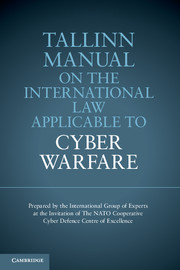2 - The use of force
Published online by Cambridge University Press: 05 March 2013
Summary
The International Court of Justice has stated that Articles 2(4) (Rules 10 to 12) and 51 (Rule 13 to 17) of the United Nations Charter, regarding the prohibition of the use of force and self-defence respectively, apply to ‘any use of force, regardless of the weapons employed’. The International Group of Experts unanimously agreed that this statement is an accurate reflection of customary international law. Therefore, the mere fact that a computer (rather than a more traditional weapon, weapon system, or platform) is used during an operation has no bearing on whether that operation amounts to a ‘use of force’. Similarly, it has no bearing on whether a State may use force in self-defence.
State practice is only beginning to clarify the application to cyber operations of the jus ad bellum, the body of international law that governs a State’s resort to force as an instrument of its national policy. In particular, the lack of agreed-upon definitions, criteria, and thresholds for application, creates uncertainty when applying the jus ad bellum to the rapidly changing realities of cyber operations. The International Group of Experts acknowledged that as cyber threats and opportunities continue to emerge and evolve, State practice may alter contemporary interpretations and applications of the jus ad bellum in the cyber context. The analysis set forth in this chapter examines the norms resident in the jus ad bellum as they exist at the time of the Manual’s adoption by the International Group of Experts in July 2012.
- Type
- Chapter
- Information
- Publisher: Cambridge University PressPrint publication year: 2013



